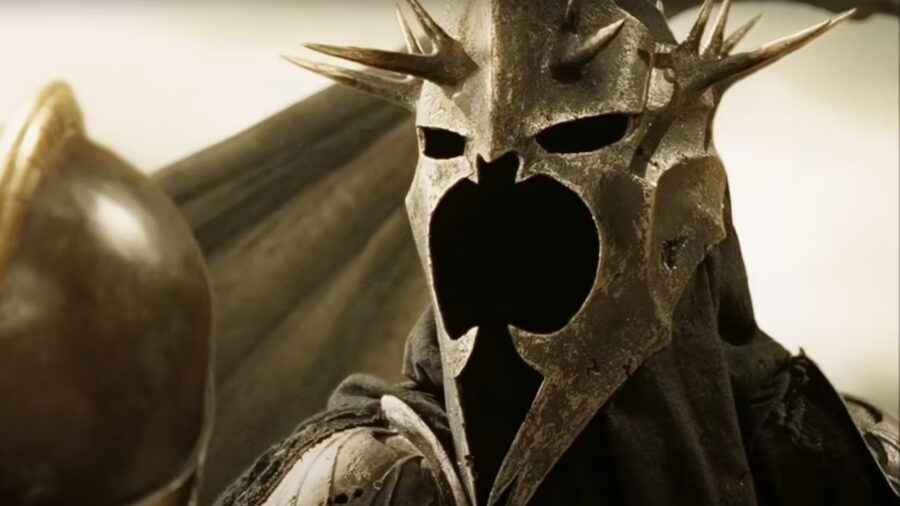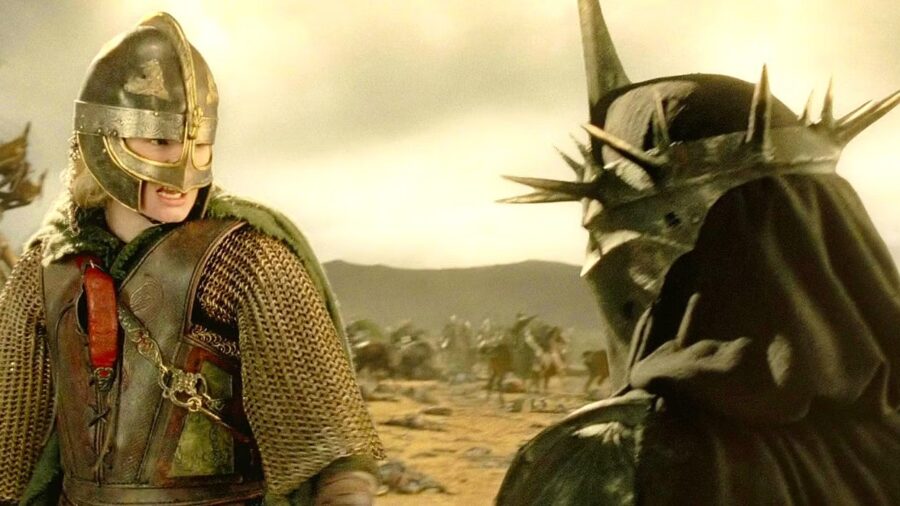Lord Of The Rings Witch-King Backstory, Explained

For those of us who love The Lord of the Rings, it takes little more than a few notes of Howard Shore’s music to immediately transport us from the modern world into a world of Hobbits, elves, and wizards. However, while J.R.R. Tolkien spent his lifetime writing charming heroes like Frodo Baggins, Gandalf, and Aragorn, he also wrote terrifying villains hungry for power and the will to stop at nothing to achieve it. While Sauron and Saruman may be the first bad guys to come to mind when thinking about Middle Earth, there is one more villain hiding in the shadows, gripping the handle of a blood-soaked black mace, with a backstory waiting to be told: the Witch-King of Angmar.
The Witch-King, commander of the Ringwraiths, is a character as complex as the universe he inhabits. Wielding a Ring of Power bestowed by the Lord of the Rings, Sauron himself, this ghoulish king commands the Black Riders and Sauron’s armies, making him a central antagonist in Tolkien’s masterpiece.
In The Lord of the Rings, The Witch-King of Angmar is one of J.R.R. Tolkien’s most terrifying villains, a mortal man so thoroughly corrupted by Sauron that he’s nearly immortal.
Tolkien spent his lifetime developing the world of Middle Earth, beginning during his time at Oxford around 1914 and continuing to 1954. Over the course of four decades, he built a complex universe encompassing the story of The Lord of the Rings, and in The Silmarillion, he dives into the shadowed history of the Witch-King, which is how we know that this Nazgul’s story began thousands of years before Biblo or Frodo Baggins were born.
Hungry for power and determined to gain control of Middle Earth, Sauron created the Rings of Power and distributed them to races across the continent. He delivered nine of these rings to powerful men who were lords of the Númenórean race—the race of people who would eventually create the Kingdom of Gondor and who are the ancestors of Aragorn. It’s assumed that the Witch-King was one of these men.
Though born to the race of man, the Witch-King’s life is extended and corrupted by the power within his ring. Gaining power and control, the Witch-King becomes the leader of the Ringwraiths and the second-in-command to Sauron.
During the Second Age of Middle Earth, he is given free rein to wreak havoc at the command of his master, but he and the other Ringwraiths disappear once Sauron is defeated by the Last Alliance, as depicted in the beginning of Peter Jackson’s Lord of the Rings: The Fellowship of the Ring.
Sauron delivered nine rings to powerful men who were lords of the Númenórean race—the race of people who would eventually create the Kingdom of Gondor and who are the ancestors of Aragorn. It’s assumed that the Witch-King was one of these men.
The Silmarillion and The Lord of the Rings books don’t say much about what happened to the Witch-King after Sauron’s downfall, and he and the other Nazguls disappear for about 1,000 years until well into the Third Age.
About 1,300 years after his disappearance, the Lord of the Nazgul reemerges and establishes the realm of Angmar, a dark domain from which he wages a relentless war against the splintered kingdom of Arnor. It is here that he officially gains the title of the Witch-King.

Eventually, the Witch-King is challenged, and he and his army engaged in a battle with the men of Gondor, elven allies, and a group of warrior Hobbits that rages on for nearly 500 years and results in the Nazgul’s defeat. It is this failure that spurs the Witch-King to go to Mordor and reunite with the Ringwraiths.
He and his Black Riders continue a journey of destruction over the course of the Third Age before they begin their quest to find the One Ring, the catalyst to Frodo’s journey in The Lord of the Rings.
Throughout The Lord of the Rings, the Witch-King’s ominous presence is one of the most terrifying aspects of Frodo’s story. Having sold his soul to the ring thousands of years ago and become immortal, a prophecy emerges declaring that no man could kill him. Confident and deadly, Sauron’s right-hand man leads his evil armies during the battles that occur in The Two Towers and The Return of the King.
The Lord of the Rings is a morality tale about the corruption of power, and no one exemplifies this more than Sauron’s lieutenant, the Witch-King.
In a fitting twist to end a merciless life, the prophecy about the Witch-King turns out to be true. It isn’t until Eowyn and Merry the Hobbit face the ghostly Nazgul during the Battle of the Pelennor Fields that the Witch-King is defeated at the hands of a woman and a halfling.
The best villains are multi-faceted with incredible backstories, like the chilling and captivating Witch-King. His transformation from a noble lord to a spectral wraith is a cautionary tale of power’s corrupting influence. While Sauron’s name might dominate discussions of evil within The Lord of the Rings’ Middle Earth, the Witch-King adds another layer of darkness to Tolkien’s complex and fantastical world.












